Spatio-Temporal Mapping of Violence Against Women: An Urban Geographic Analysis Based on 911 Emergency Reports in Monterrey
Abstract
1. Introduction
1.1. Violence Against Women in Context
1.2. Spatial Analysis Techniques Applied to Crime
1.3. Literature Review: Spatial Analysis Applied to VAW
2. Materials and Methods
2.1. Study Area
2.2. Methods
2.2.1. Data Processing
2.2.2. Temporal Analysis
2.2.3. Spatial Pattern Analysis
2.2.4. Spatial Parameter Selection
2.2.5. Hourly Band Spatio-Temporal Analysis
2.2.6. Density Analysis
3. Results
3.1. Descriptive Statistics
3.2. Temporal Pattern Analysis
3.2.1. Pre-Pandemic Behavior (2019)
3.2.2. Pandemic Impact (2020)
3.2.3. Peak of Violence Against Women (2021)
3.2.4. Post-Pandemic Stabilization (2022)
3.2.5. Hourly Patterns Pre-Pandemic and During Lockdown
3.3. Spatial Distribution and Clustering
3.3.1. Spatial Distribution of Violence Types
3.3.2. Spatial Clustering of Violence Against Women
3.3.3. Spatio-Temporal Evolution of Violence Patterns
4. Discussion
5. Conclusions
Author Contributions
Funding
Data Availability Statement
Acknowledgments
Conflicts of Interest
References
- Pinargote-Zamora, M.J. Derechos Humanos y Violencia de Género En Ecuador. Rev. Científica Arbitr. Psicol. NUNA YACHAY 2022, 5, 2–16. [Google Scholar] [CrossRef]
- Fernandez-Sanchez, M.; Lopez-Zafra, E. Intimate Partner Violence Against Women (IPVAW): Resilience and Emotional Intelligence as Health Protectors; Gender Violence: Prevalence, Implications and Global Perspectives; Nova Science Publishers: Hauppauge, NY, USA, 2018; pp. 67–92. ISBN 9781536136111. [Google Scholar]
- Meneses-La-Riva, M.E.; Ocupa-Cabrera, H.G.; Ocupa-Meneses, G.D.D.; Paredes-Díaz, S.E.; Ocupa-Meneses, B.D.D.; Vera-Calmet, V.G. A Narrative Review of Scientific Evidences Regarding Characteristics of Gender-Based Violence in Intimate Partners. Acad. J. Interdiscip. Stud. 2023, 12, 248–256. [Google Scholar] [CrossRef]
- Mormontoy-Morales, A.E. Analysis of the Novel “No Se Lo Digas a Nadie” as an Instrument to Understand Masculinity and Gender Violence. Rev. Neuropsiquiatr. 2020, 83, 45–50. [Google Scholar] [CrossRef]
- Patró-Hernández, R.M. Chapter 7—Intimate Partner Violence Against Women: Prevention and Intervention Strategies in Spain. In The Psychology of Gender and Health; Sánchez-López, M.P., Limiñana-Gras, R.M., Eds.; Academic Press: San Diego, CA, USA, 2017; pp. 199–229. ISBN 978-0-12-803864-2. [Google Scholar]
- Herrera Giraldo, M.; González Espitia, C.; Ochoa Díaz, H. The Spatial and Economic Relationship between Labour Informality and Homicides in Cali, Colombia. Dev. Policy Rev. 2023, 41, e12709. [Google Scholar] [CrossRef]
- Tiravanti-Delgado, D. Bajo Prevalence and Factors Associated with Different Types of Intimate Partner Violence in Peruvian Women; Revista Cubana de Medicina Militar: La Habana, Cuba, 2021; Volume 50. [Google Scholar]
- Bott, S.; Guedes, A.; Ruiz-Celis, A.P.; Mendoza, J.A. Intimate Partner Violence in the Americas: A Systematic Review and Reanalysis of National Prevalence Estimates. Rev. Panam. Salud Publica/Pan Am. J. Public Health 2021, 45, e26. [Google Scholar] [CrossRef]
- Organización Mundial de la Salud [OMS]. Violencia Contra Las Mujeres: Estimaciones Mundiales e Impacto. Available online: https://www.who.int/es/news-room/fact-sheets/detail/violence-against-women (accessed on 2 June 2025).
- Thobejane, T. Effects of Gender-Based Violence Towards Young Females: The Case of Vhufuli Village in Thohoyandou, Limpopo Province-South Africa. J. Rev. Glob. Econ. 2019, 8, 53–62. [Google Scholar] [CrossRef]
- Falb, K.; Peterman, A.; Nordås, R.; Field, A.; Porat, R.; Stark, L. Violence against Women and Girls Research: Leveraging Gains across Disciplines. Proc. Natl. Acad. Sci. USA 2025, 122, e2404557122. [Google Scholar] [CrossRef]
- Quintero-Avila, O. Análisis espacial del delito: Violencia de género en Monterrey, Nuevo León. In Perspectivas Criminológicas. En la Inteligencia Criminal Estratégica; Catillo, M.A.G., Avila, O.Q., Delgadillo, J.A.C., Eds.; Tirant Humanidades: Mexico City, Mexico, 2025; Volume 1, pp. 63–104. ISBN 978-84-1081-034-1. [Google Scholar]
- Quintero-Avila, O. El Análisis y mapeo delictivo para el desarrollo de políticas públicas de seguridad en México. Constr. Criminológicos 2024, 4, 159–170. [Google Scholar] [CrossRef]
- Quintero-Avila, O.; Caballero-Delgadillo, J.A. Percepción de Inseguridad Urbana: Enfoque Geoespacial para el análisis criminológico. Dilemas Contemp. Educ. Política Valores 2025, 12, 1–25. [Google Scholar] [CrossRef]
- Instituto Nacional de Estadística y Geografía (ENDIREH). Encuesta Nacional Sobre la Dinámica de las Relaciones en los Hogares (ENDIREH). Available online: https://www.inegi.org.mx/programas/endireh/ (accessed on 2 June 2025).
- García, S. Tercer Informe de Gobierno: Indicadores Sectoriales; Gobierno del Estado de Nuevo León: Nuevo León, Mexico, 2022. [Google Scholar]
- INEGI ENDIREH 2021: Resultados Nuevo León. Available online: https://www.inegi.org.mx/programas/endireh/2021/ (accessed on 7 June 2025).
- Russo Rafael, R.d.M.; Jalil, E.; Velasque, L.; Friedman, R.; Ramos, M.; Monteiro, L. Intimate Partner Violence among Brazilian Trans and Cisgender Women Living with Hiv or at Hiv Risk. Transgend Health 2025, 10, 63–72. [Google Scholar] [CrossRef]
- Jiménez, I.T.B.; Ávila, N.R. Factors associated with domestic violence in women: Systematic Ecological Review. Rev. Cuid. 2025, 16, e3857. [Google Scholar]
- Gabriela, E.; Huerta, R. La Ciudad Desde Las Mujeres: Análisis de Los Obstáculos de Movilidad Para Las Mujeres En La Zona Metropolitana de Monterrey. Rev. Estud. 2021, 43, 2021. [Google Scholar] [CrossRef]
- Garcia-Cervantes, N. Urban Violence as the Politics of Space in Monterrey, Mexico. Int. Dev. Plan. Rev. 2025, 47, 199–221. [Google Scholar] [CrossRef]
- Mondal, S.; Singh, D.; Kumar, R. Crime Hotspot Detection Using Statistical and Geospatial Methods: A Case Study of Pune City, Maharashtra, India. GeoJournal 2022, 87, 5287–5303. [Google Scholar] [CrossRef]
- Roy, S.; Chowdhury, I.R. Geography of Crime against Women in West Bengal, India: Identifying Spatio-Temporal Dynamics and Hotspots. GeoJournal 2023, 88, 5863–5895. [Google Scholar] [CrossRef]
- Hashim, H.; Wan Mohd, W.M.N.; Sadek, E.S.S.M.; Dimyati, K.M. Modeling Urban Crime Patterns Using Spatitial Space Time and Regression. In Proceedings of the International Archives of the Photogrammetry, Remote Sensing and Spatial Information Sciences—ISPRS; International Society for Photogrammetry and Remote Sensing: Kuala Lumpur, Malaysia, 2019; Volume 62, pp. 247–254. [Google Scholar]
- Carrillo-Brenes, F.; Vilches-Blázquez, L.M. Characterizing Spatio-Temporal Patterns of Child Sexual Abuse in Mexico City Before, During, and After the COVID-19 Pandemic. ISPRS Int. J. Geoinf. 2024, 13, 223. [Google Scholar] [CrossRef]
- Sadler, R.C.; Melde, C.; Zeoli, A.; Wolfe, S.; O’Brien, M. Characterizing Spatio-Temporal Differences in Homicides and Non-Fatal Shootings in Milwaukee, Wisconsin, 2006–2015. Appl. Spat. Anal. Policy 2022, 15, 117–142. [Google Scholar] [CrossRef]
- Pérez-Fernández, O.; Michel, G.R. Spatial Accessibility to Healthcare Facilities: GIS-Based Public–Private Comparative Analysis Using Floating Catchment Methods. ISPRS Int. J. Geoinf. 2025, 14, 253. [Google Scholar] [CrossRef]
- Mohammed, A.F.; Baiee, W.R. The GIS Based Criminal Hotspot Analysis Using DBSCAN Technique. In Proceedings of the IOP Conference Series: Materials Science and Engineering, Thi-Qar, Iraq, 15–16 July 2020; IOP Publishing Ltd.: Bristol, UK, 2020; Volume 928. [Google Scholar]
- Nepomuceno, T.C.C.; Costa, A.P.C.S. Spatial Visualization on Patterns of Disaggregate Robberies. Oper. Res. 2019, 19, 857–886. [Google Scholar] [CrossRef]
- Luo, J. Multi-Spatiotemporal Patterns of Residential Burglary Crimes in Chicago: 2006–2016. In Proceedings of the 2nd International Symposium on Spatiotemporal Computing, Cambridge, MA, USA, 7–9 August 2017; ISPRS Annals of the Photogrammetry, Remote Sensing and Spatial Information Sciences: Cambridge, MA, USA, 2017; Volume 4, pp. 193–198. [Google Scholar]
- Lee, J.; Leitner, M.; Paulus, G. Spatiotemporal Analysis of Nighttime Crimes in Vienna, Austria. ISPRS Int. J. Geoinf. 2024, 13, 247. [Google Scholar] [CrossRef]
- Wang, R.; Li, Y. Bayesian Structural Time Series and Geographically Weighted Logistic Regression Modelling Impacts of COVID-19 Lockdowns on the Spatiotemporal Patterns of London’s Crimes. ISPRS Int. J. Geoinf. 2024, 13, 18. [Google Scholar] [CrossRef]
- Du, Y.; Ding, N. A Systematic Review of Multi-Scale Spatio-Temporal Crime Prediction Methods. ISPRS Int. J. Geoinf. 2023, 12, 209. [Google Scholar] [CrossRef]
- Gracia, E.; Marco, M.; López-Quílez, A.; Lila, M. Chronic High Risk of Intimate Partner Violence against Women in Disadvantaged Neighborhoods: An Eight-Year Space-Time Analysis. Prev. Med. 2021, 148, 106550. [Google Scholar] [CrossRef]
- Bunch, R.L.; Murray, C.; Gao, X.; Hunt, E.D. Geographic Analysis of Domestic Violence Incident Locations and Neighborhood Level Influences. Int. J. Appl. Geospat. Res. 2018, 9, 14–32. [Google Scholar] [CrossRef]
- Wei, B.; Cui, Z.; Wu, Q.; Guo, S.; Li, W.; Wang, X.; Qiu, W. Investigating the Spatiotemporally Heterogeneous Effects of Macro and Micro Built Environment on Sexual Violence against Women: A Case Study of Mumbai. Humanit. Soc. Sci. Commun. 2025, 12, 502. [Google Scholar] [CrossRef]
- Ibarra-Cabrera, M.J.; Ibarra-Cabrera, E.M.; García Vázquez, Y.; Ferrás, C. Analysis of the Location and Spatial Distribution of Violence Against Women in Peru. Soc. Sci. 2025, 14, 76. [Google Scholar] [CrossRef]
- Melo, S.N.; Boivin, R.; Morselli, C. Spatial Dark Figures of Rapes: (In) Consistencies across Police and Hospital Data. J. Environ. Psychol. 2020, 68, 101393. [Google Scholar] [CrossRef]
- Butt, U.M.; Letchmunan, S.; Hassan, F.H.; Ali, M.; Baqir, A.; Sherazi, H.H.R. Spatio-Temporal Crime Hotspot Detection and Prediction: A Systematic Literature Review. IEEE Access 2020, 8, 166553–166574. [Google Scholar] [CrossRef]
- INEGI Censo de Población y Vivienda. Available online: https://www.inegi.org.mx/programas/ccpv/2020/ (accessed on 5 June 2025).
- Bennett, L.; Vale, F. Spatial Statistics Illustrated, 1st ed.; Esri Press: Redlands, CA, USA, 2023. [Google Scholar]
- Anselin, L. Local Indicators of Spatial Association—LISA. Geogr. Anal. 1995, 27, 93–115. [Google Scholar] [CrossRef]
- Harris, N.L.; Goldman, E.; Gabris, C.; Nordling, J.; Minnemeyer, S.; Ansari, S.; Lippmann, M.; Bennett, L.; Raad, M.; Hansen, M.; et al. Using Spatial Statistics to Identify Emerging Hot Spots of Forest Loss. Environ. Res. Lett. 2017, 12, 024012. [Google Scholar] [CrossRef]
- Cuba, N.; Sauls, L.A.; Bebbington, A.J.; Bebbington, D.H.; Chicchon, A.; Marimón, P.D.; Diaz, O.; Hecht, S.; Kandel, S.; Osborne, T.; et al. Emerging Hot Spot Analysis to Indicate Forest Conservation Priorities and Efficacy on Regional to Continental Scales: A Study of Forest Change in Selva Maya 2000–2020. Environ. Res. Commun. 2022, 4, 071004. [Google Scholar] [CrossRef]
- Ghanghermeh, A.; Roshan, G.; Asadi, K.; Attia, S. Spatiotemporal Analysis of Urban Heat Islands and Vegetation Cover Using Emerging Hotspot Analysis in a Humid Subtropical Climate. Atmosphere 2024, 15, 161. [Google Scholar] [CrossRef]
- Bunting, R.J.; Chang, O.Y.; Cowen, C.; Hankins, R.; Langston, S.; Warner, A.; Yang, X.; Louderback, E.R.; Roy, S. Sen Spatial Patterns of Larceny and Aggravated Assault in Miami–Dade County, 2007–2015. Prof. Geogr. 2018, 70, 34–46. [Google Scholar] [CrossRef]
- Siabato, W.; Guzmán-Manrique, J. La Autocorrelación Espacial y El Desarrollo de La Geografía Cuantitativa. Cuad. Geogr. Rev. Colomb. Geogr. 2019, 28, 1–22. [Google Scholar] [CrossRef]
- Tavares, J.P.; Costa, A.C. Spatial Modeling and Analysis of the Determinants of Property Crime in Portugal. ISPRS Int. J. Geoinf. 2021, 10, 731. [Google Scholar] [CrossRef]
- López-Hernández, E.; Rubio-Amores, D. Reflexiones Sobre La Violencia Intrafamiliar y Violencia de Género Durante Emergencia Por COVID-19. CienciAmérica 2020, 9, 312–321. [Google Scholar] [CrossRef]
- Kabiraj, P. Crime against Women in India: A Spatio-Temporal Analysis. Pap. Appl. Geogr. 2023, 9, 261–278. [Google Scholar] [CrossRef]
- Cueva, D.; Cabrera-Barona, P. Spatial, Temporal, and Explanatory Analyses of Urban Crime. Soc. Indic. Res. 2024, 174, 611–629. [Google Scholar] [CrossRef]
- Irandegani, Z.; Mohammadi, R.; Taleai, M. Investigating Temporal and Spatial Effects of Urban Planning Variables on Crime Rate: A Gwr and Ols Based Approach. In Proceedings of the GeoSpatial Conference 2019—Joint Conferences of SMPR and GI Research, Karaj, Iran, 12–14 October 2019; International Society for Photogrammetry and Remote Sensing: Baton Rouge, LA, USA, 2019; Volume 42, pp. 559–564. [Google Scholar]
- Towers, S.; Chen, S.; Malik, A.; Ebert, D. Factors Influencing Temporal Patterns in Crime in a Large American City: A Predictive Analytics Perspective. PLoS ONE 2018, 13, e0205151. [Google Scholar] [CrossRef]
- Wang, D.; Fei, L.; Chai, Y. Activity Spaces and Sociospatial Segregation in Beijing. Urban Geogr. 2012, 33, 256–277. [Google Scholar] [CrossRef]
- Hu, Y.; Wang, F.; Guin, C.; Zhu, H. A Spatio-Temporal Kernel Density Estimation Framework for Predictive Crime Hotspot Mapping and Evaluation. Appl. Geogr. 2018, 99, 89–97. [Google Scholar] [CrossRef]
- Spencer Chainey Understanding Crime. Analyzing the Geography of Crime; Esri Press: Redlands, CA, USA, 2021; ISBN 9781589485846. [Google Scholar]
- Chainey, S.; Tompson, L.; Uhlig, S. The Utility of Hotspot Mapping for Predicting Spatial Patterns of Crime. Secur. J. 2008, 21, 4–28. [Google Scholar] [CrossRef] [PubMed]
- Eck, J.E.; Weisburd, D.; Eck, J. Crime Places in Crime Theory. Crime Place Crime Prev. Stud. 2015, 4, 1–33. [Google Scholar]
- Bandura, A.; Walters, R.H. Social Learning Theory; Prentice Hall: Englewood Cliffs, NJ, USA, 1977; Volume 1, pp. 141–154. [Google Scholar]
- UN Women la Pandemia en la Sombra: Violencia Contra las Mujeres Durante el Confinamiento. Available online: https://www.unwomen.org/es/news/in-focus/in-focus-gender-equality-in-covid-19-response/violence-against-women-during-covid-19 (accessed on 2 June 2025).
- Cohen, L.E.; Felson, M. Social Change and Crime Rate Trends: A Routine Activity Approach. Am. Sociol. Rev. 1979, 44, 588. [Google Scholar] [CrossRef]
- Brantingham, P.L.; Brantingham, P.J. 21 Nodes, Paths and Edges: Considerations on the Complexity of Crime and the Physical Environment. In Social, Ecological and Environmental Theories of Crime; Routledge: Oxfordshire, UK, 2017; pp. 363–388. [Google Scholar]
- Crow, T. Crime Prevention through Environmental Design; National Crime Prevention Institute: China Spring, TX, USA, 2000. [Google Scholar]
- Crowe, T.D. Crime Prevention through Environmental Design: Applications of Architectural Design and Space Management Concepts; Butterworth-Heinemann: Oxford, UK, 2000. [Google Scholar]
- Weisburd, D. The Law of Crime Concentration and the Criminology of Place. Criminology 2015, 53, 133–157. [Google Scholar] [CrossRef]
- Felson, M.; de Melo, S.N.; Boivin, R. Risk of Outdoor Rape and Proximity to Bus Stops, Bars, and Residences. Violence Vict. 2021, 36, 723–738. [Google Scholar] [CrossRef]
- Perez-Vincent, S.M.; Carreras, E. Domestic Violence Reporting during the COVID-19 Pandemic: Evidence from Latin America. Rev. Econ. Househ. 2022, 20, 799–830. [Google Scholar] [CrossRef]
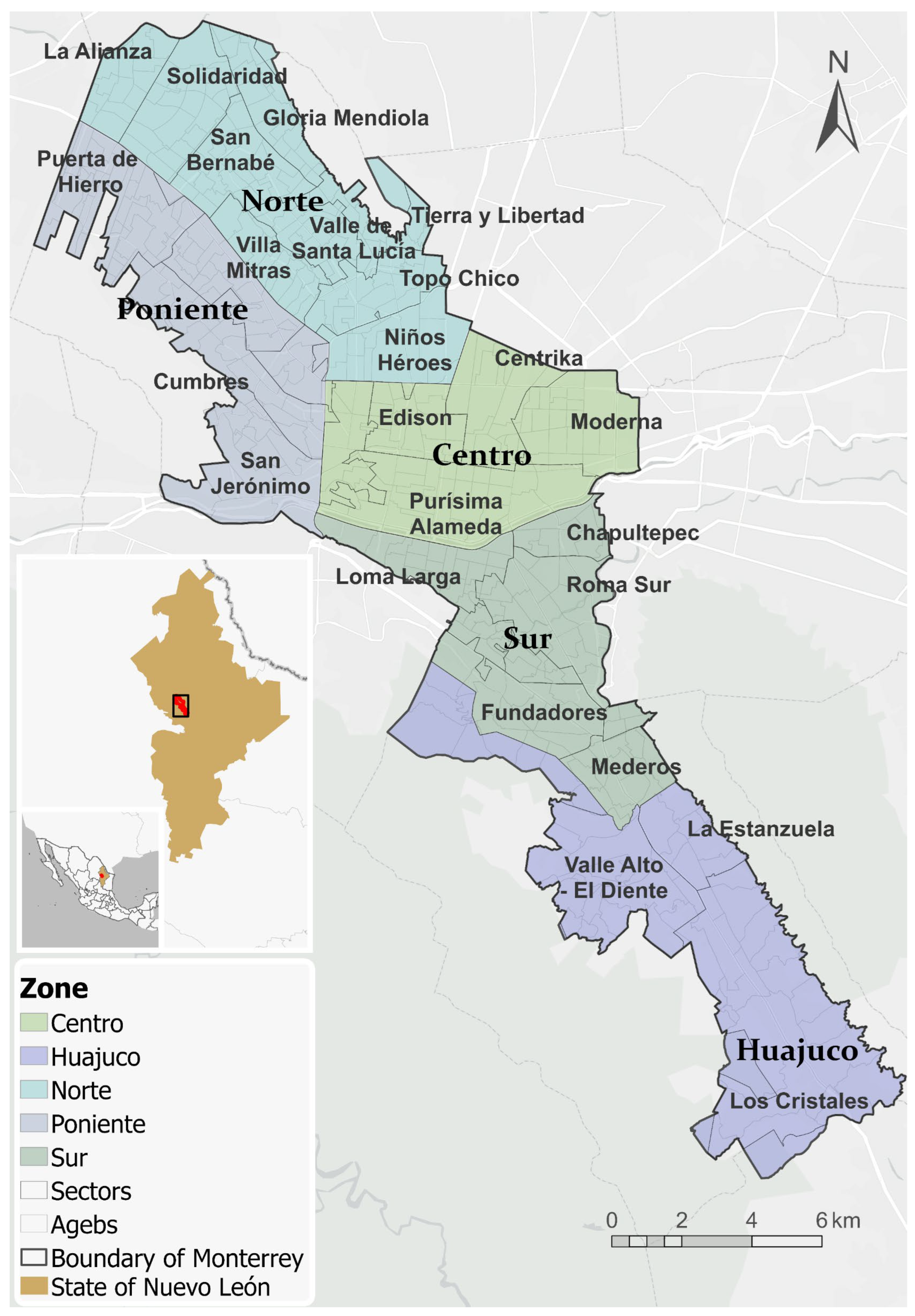
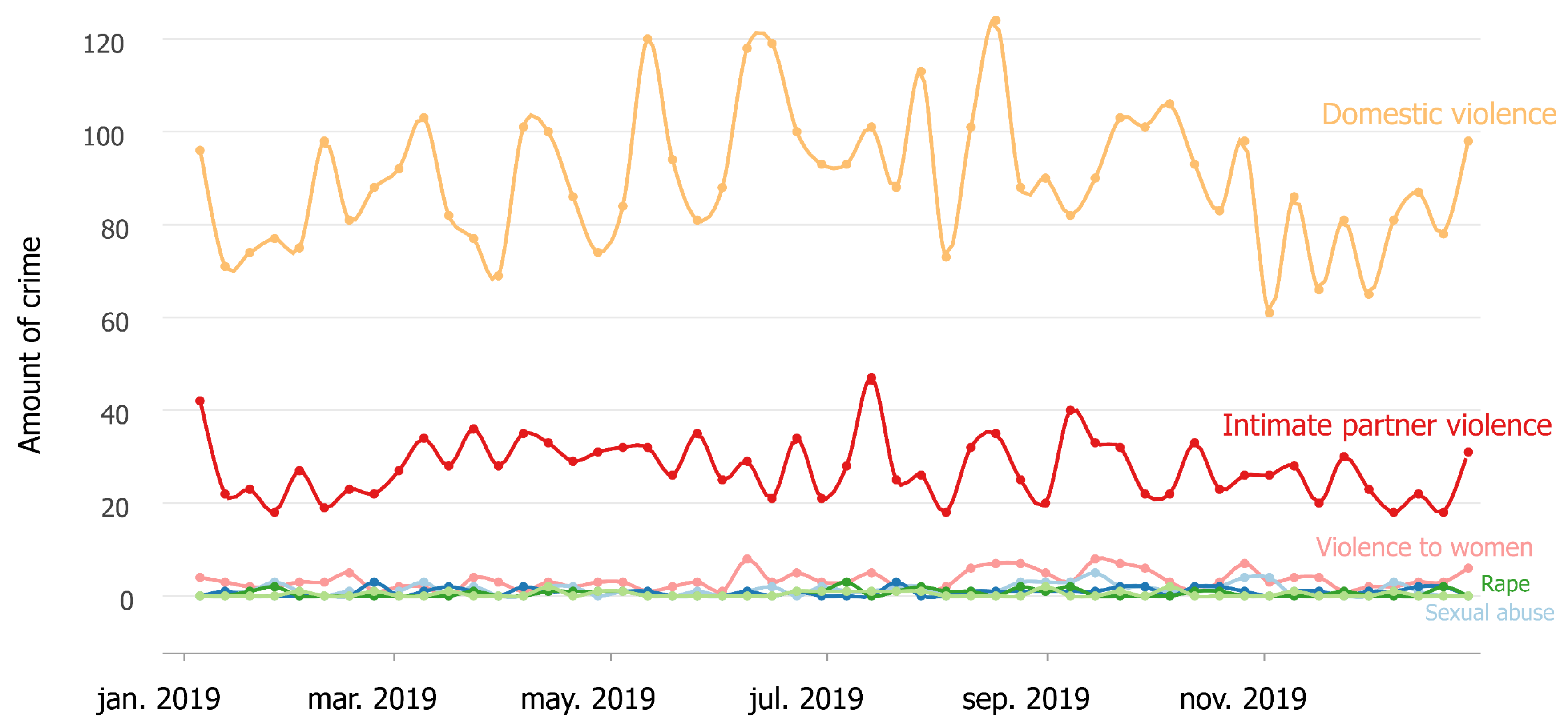
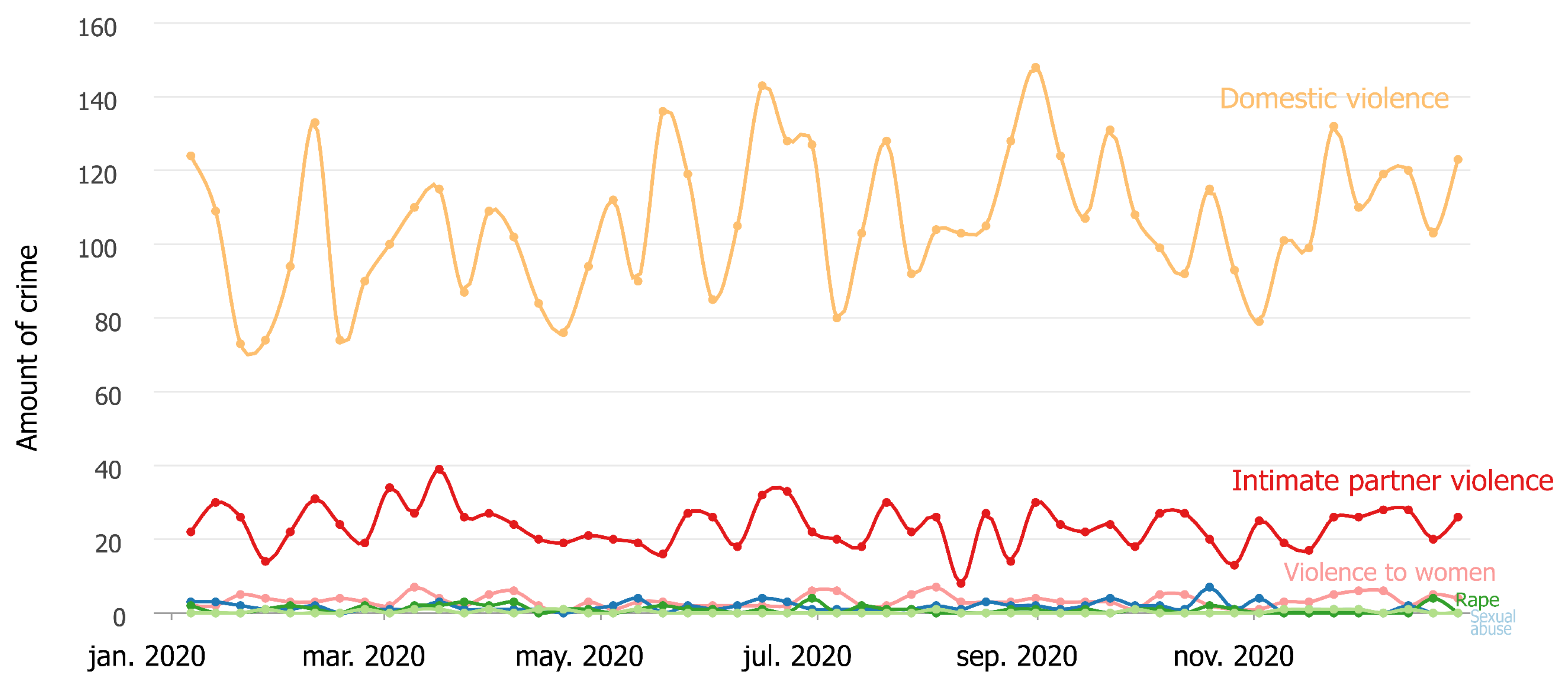
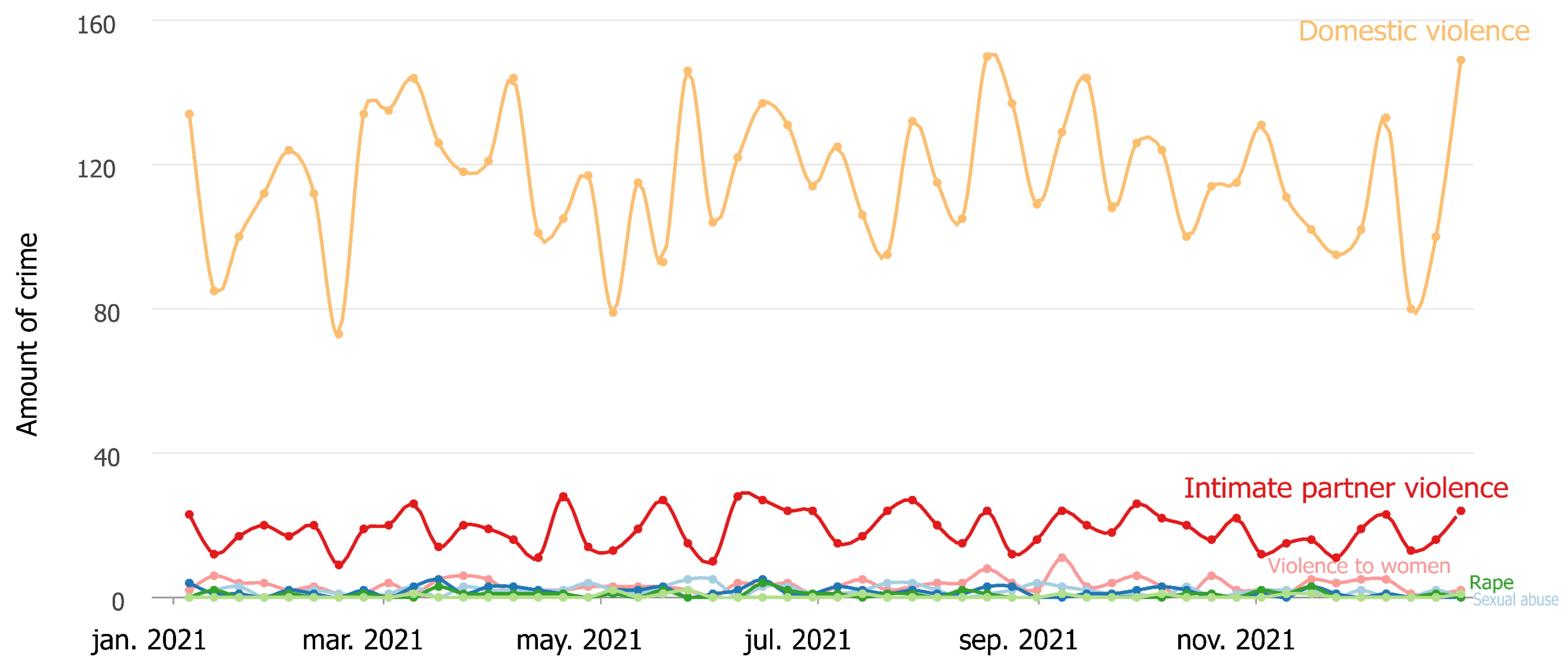
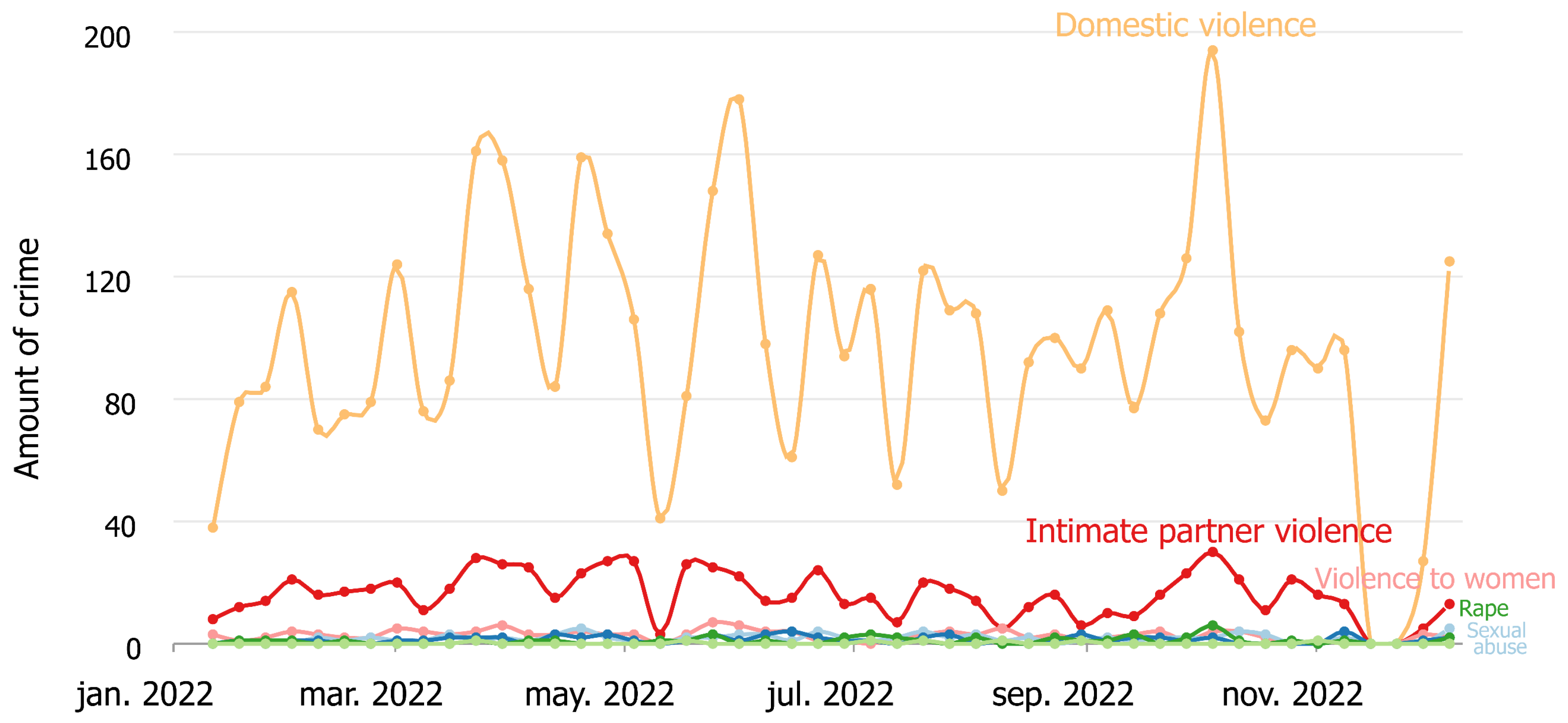
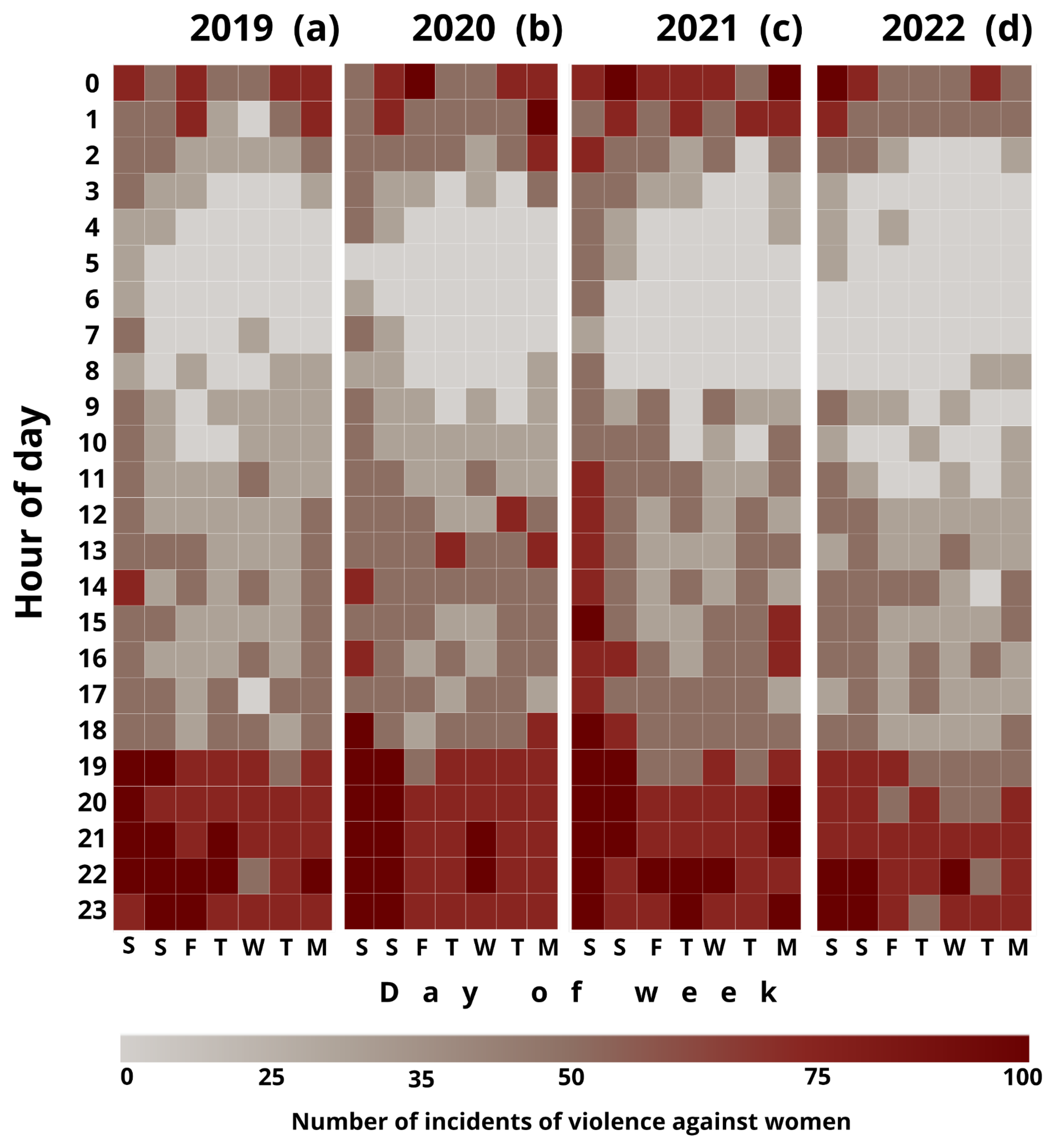

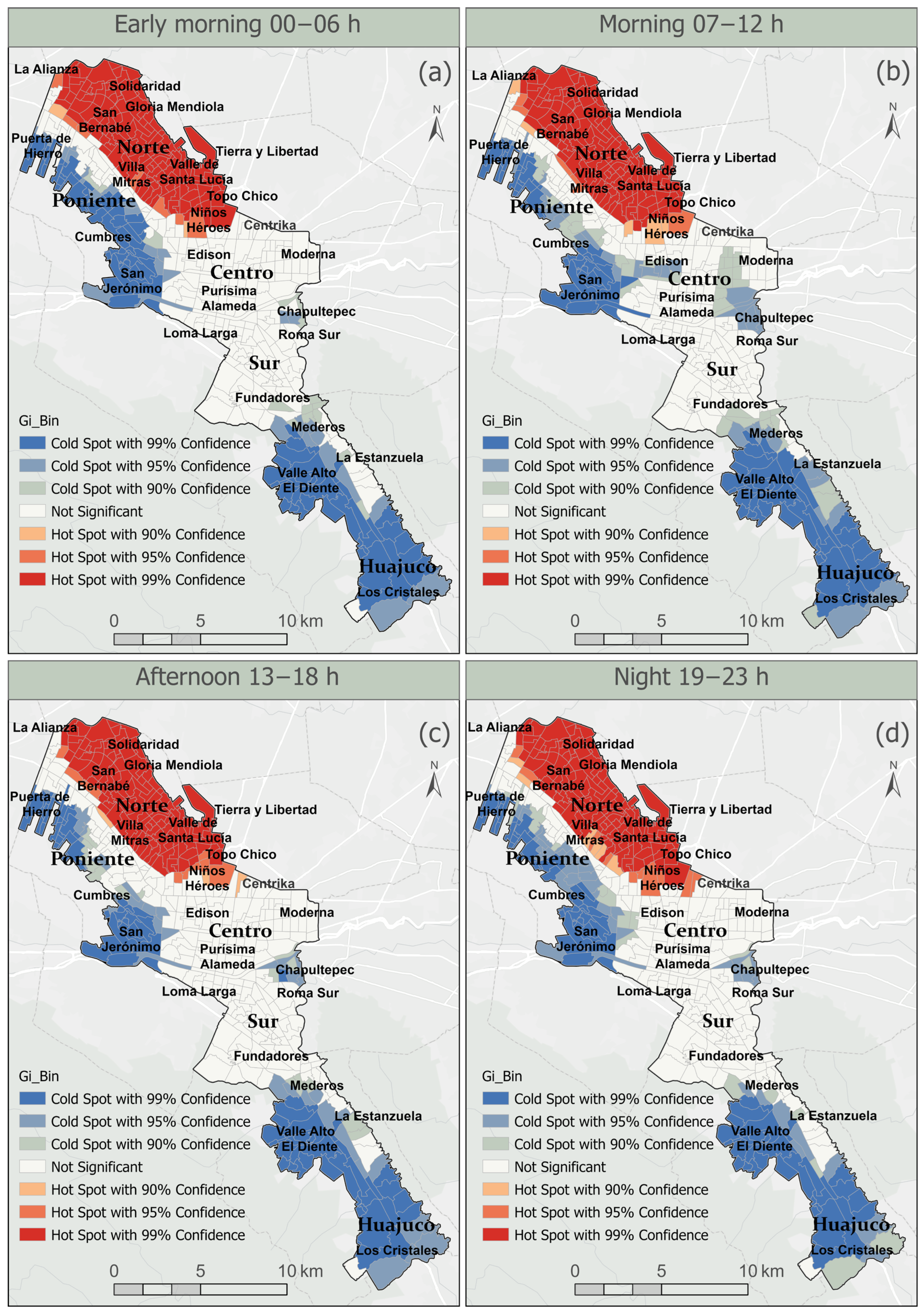
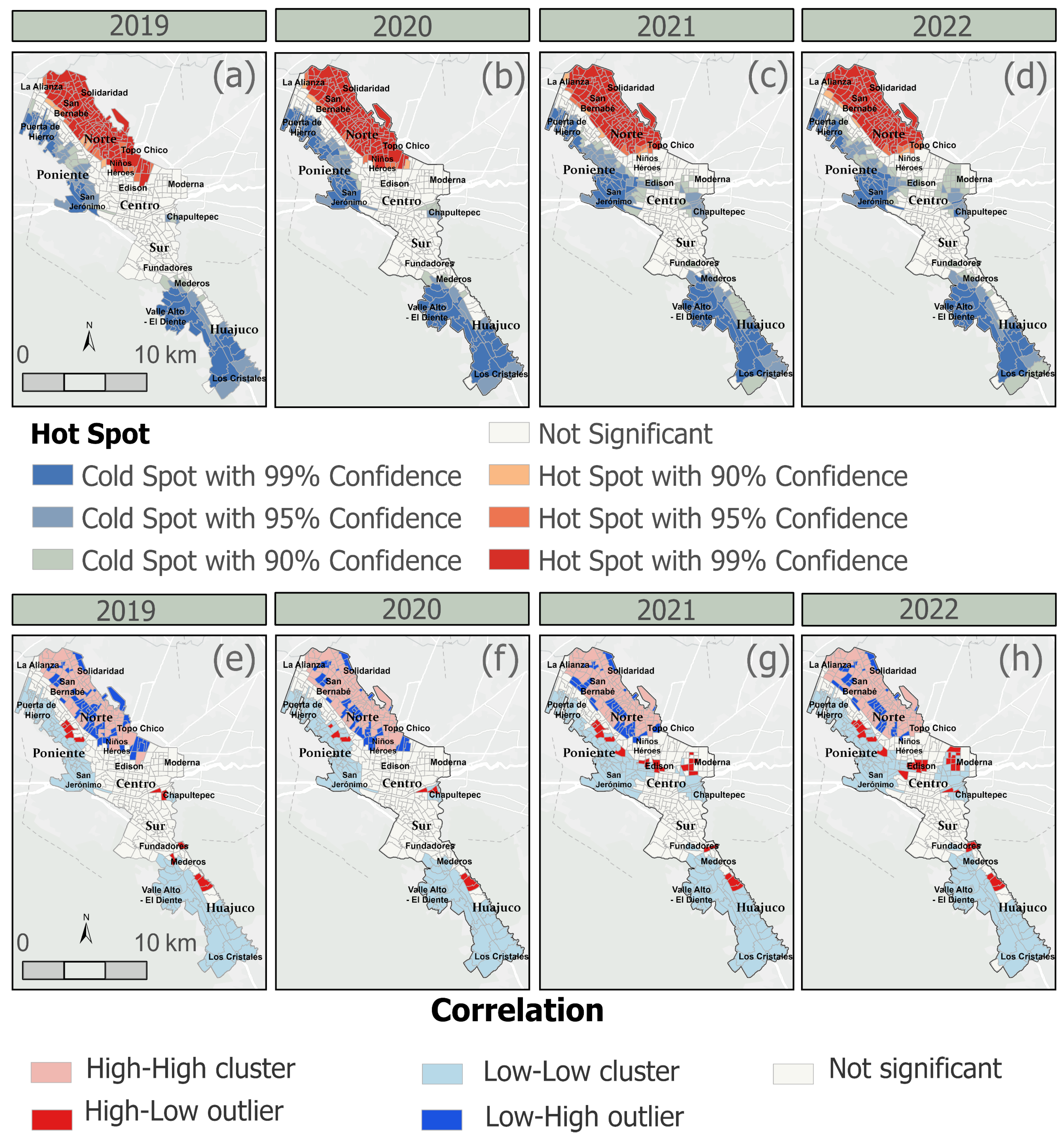

| Year | Mean | SD | Min | Max | Sum |
|---|---|---|---|---|---|
| 2019 | 17.8 | 7.1 | 2 | 51 | 6482 |
| 2020 | 19.7 | 7.5 | 5 | 48 | 7221 |
| 2021 | 20.4 | 8.3 | 4 | 54 | 7449 |
| 2022 | 19.9 | 9.2 | 1 | 55 | 5884 |
| Crime Type | Mean | SD | Min | Max | Sum |
|---|---|---|---|---|---|
| Sexual abuse | 1.2 | 0.4 | 1 | 3 | 335 |
| Sexual harassment or assault | 1.1 | 0.4 | 1 | 3 | 266 |
| Other acts against sexual freedom/safety | 1.0 | 0.0 | 1 | 1 | 54 |
| Rape | 1.1 | 0.4 | 1 | 3 | 162 |
| Violence against women (general category) | 1.3 | 0.6 | 1 | 4 | 654 |
| Intimate partner violence | 3.4 | 1.9 | 1 | 14 | 4437 |
| Domestic violence | 15.2 | 7.0 | 1 | 48 | 21,128 |
| Day | 2019 | 2020 | ||||||||
|---|---|---|---|---|---|---|---|---|---|---|
| Mean | SD | Min | Max | Sum | Mean | SD | Min | Max | Sum | |
| Monday | 18.5 | 7.1 | 2 | 40 | 961 | 20.0 | 5.5 | 10 | 31 | 1038 |
| Tuesday | 15.3 | 6.4 | 6 | 42 | 810 | 18.6 | 7.4 | 5 | 45 | 966 |
| Wednesday | 15.7 | 6.4 | 4 | 31 | 815 | 17.5 | 5.8 | 8 | 31 | 925 |
| Thursday | 16.0 | 5.3 | 5 | 32 | 832 | 17.2 | 6.9 | 6 | 36 | 911 |
| Friday | 17.0 | 7.1 | 4 | 33 | 884 | 18.7 | 7.5 | 7 | 48 | 970 |
| Saturday | 18.9 | 5.6 | 6 | 34 | 984 | 21.8 | 6.6 | 9 | 41 | 1135 |
| Sunday | 23.0 | 8.6 | 8 | 51 | 1196 | 24.5 | 9.9 | 9 | 47 | 1276 |
| Day | 2021 | 2022 | ||||||||
| Mean | SD | Min | Max | Sum | Mean | SD | Min | Max | Sum | |
| Monday | 20.6 | 7.4 | 4 | 40 | 1069 | 19.1 | 6.4 | 1 | 36 | 802 |
| Tuesday | 17.4 | 6.0 | 7 | 37 | 905 | 17.2 | 7.9 | 5 | 43 | 723 |
| Wednesday | 18.8 | 9.2 | 9 | 53 | 980 | 18.2 | 8.5 | 3 | 34 | 782 |
| Thursday | 17.9 | 5.7 | 6 | 32 | 933 | 17.6 | 7.1 | 4 | 33 | 739 |
| Friday | 18.3 | 7.5 | 4 | 39 | 968 | 19.1 | 11.0 | 5 | 51 | 803 |
| Saturday | 21.9 | 7.2 | 11 | 54 | 1140 | 23.2 | 11.0 | 4 | 55 | 973 |
| Sunday | 28.0 | 9.5 | 7 | 53 | 1454 | 25.3 | 10.0 | 7 | 52 | 1062 |
Disclaimer/Publisher’s Note: The statements, opinions and data contained in all publications are solely those of the individual author(s) and contributor(s) and not of MDPI and/or the editor(s). MDPI and/or the editor(s) disclaim responsibility for any injury to people or property resulting from any ideas, methods, instructions or products referred to in the content. |
© 2025 by the authors. Published by MDPI on behalf of the International Society for Photogrammetry and Remote Sensing. Licensee MDPI, Basel, Switzerland. This article is an open access article distributed under the terms and conditions of the Creative Commons Attribution (CC BY) license (https://creativecommons.org/licenses/by/4.0/).
Share and Cite
Pérez-Fernández, O.; Quintero Ávila, O.; Barros, C.; Rosario Michel, G. Spatio-Temporal Mapping of Violence Against Women: An Urban Geographic Analysis Based on 911 Emergency Reports in Monterrey. ISPRS Int. J. Geo-Inf. 2025, 14, 367. https://doi.org/10.3390/ijgi14100367
Pérez-Fernández O, Quintero Ávila O, Barros C, Rosario Michel G. Spatio-Temporal Mapping of Violence Against Women: An Urban Geographic Analysis Based on 911 Emergency Reports in Monterrey. ISPRS International Journal of Geo-Information. 2025; 14(10):367. https://doi.org/10.3390/ijgi14100367
Chicago/Turabian StylePérez-Fernández, Onel, Octavio Quintero Ávila, Carolina Barros, and Gregorio Rosario Michel. 2025. "Spatio-Temporal Mapping of Violence Against Women: An Urban Geographic Analysis Based on 911 Emergency Reports in Monterrey" ISPRS International Journal of Geo-Information 14, no. 10: 367. https://doi.org/10.3390/ijgi14100367
APA StylePérez-Fernández, O., Quintero Ávila, O., Barros, C., & Rosario Michel, G. (2025). Spatio-Temporal Mapping of Violence Against Women: An Urban Geographic Analysis Based on 911 Emergency Reports in Monterrey. ISPRS International Journal of Geo-Information, 14(10), 367. https://doi.org/10.3390/ijgi14100367







